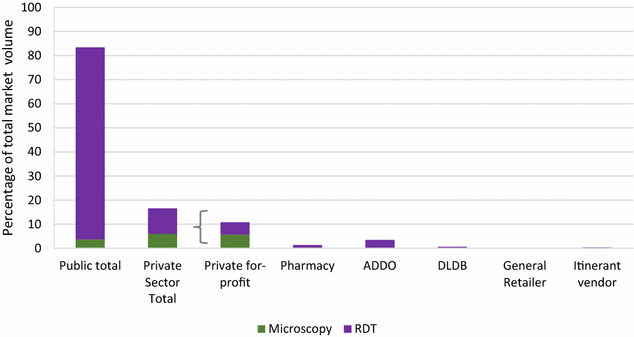The malaria testing and treatment landscape in mainland Tanzania, 2016
- PMID: 28521811
- PMCID: PMC5437635
- DOI: 10.1186/s12936-017-1819-7
The malaria testing and treatment landscape in mainland Tanzania, 2016
Abstract
Background: Understanding the key characteristics of malaria testing and treatment is essential to the control of a disease that continues to pose a major risk of morbidity and mortality in mainland Tanzania, with evidence of a resurgence of the disease in recent years. The introduction of artemisinin combination therapy (ACT) as the first-line treatment for malaria, alongside policies to promote rational case management following testing, highlights the need for evidence of anti-malarial and testing markets in the country. The results of the most recent mainland Tanzania ACTwatch outlet survey are presented here, including data on the availability, market share and price of anti-malarials and malaria diagnosis in 2016.
Methods: A nationally-representative malaria outlet survey was conducted between 18th May and 2nd July, 2016. A census of public and private outlets with potential to distribute malaria testing and/or treatment was conducted among a representative sample of administrative units. An audit was completed for all anti-malarials, malaria rapid (RDT) diagnostic tests and microscopy.
Results: A total of 5867 outlets were included in the nationally representative survey, across both public and private sectors. In the public sector, availability of malaria testing was 92.3% and quality-assured (QA) ACT was 89.1% among all screened outlets. Sulfadoxine-pyrimethamine (SP) was stocked by 51.8% of the public sector and injectable artesunate was found in 71.4% of all screened public health facilities. Among anti-malarial private-sector stockists, availability of testing was 15.7, and 65.1% had QA ACT available. The public sector accounted for 83.4% of the total market share for malaria diagnostics. The private sector accounted for 63.9% of the total anti-malarial market, and anti-malarials were most commonly distributed through accredited drug dispensing outlets (ADDOs) (39.0%), duka la dawa baridi (DLDBs) (13.3%) and pharmacies (6.7%). QA ACT comprised 33.1% of the national market share (12.2% public sector and 20.9% private sector). SP accounted for 53.3% of the total market for anti-malarials across both private and public sectors (31.3 and 22.0% of the total market, respectively). The median price per adult equivalent treatment dose (AETD) of QA ACT in the private sector was $1.40, almost 1.5 times more expensive than the median price per AETD of SP ($1.05). In the private sector, 79.3% of providers perceived ACT to be the most effective treatment for uncomplicated malaria for adults and 88.4% perceived this for children.
Conclusions: While public sector preparedness for appropriate malaria testing and case management is showing encouraging signs, QA ACT availability and market share in the private sector continues to be sub-optimal for most outlet types. Furthermore, it is concerning that SP continues to predominate in the anti-malarial market. The reasons for this remain unclear, but are likely to be in part related to price, availability and provider knowledge or preferences. Continued efforts to implement government policy around malaria diagnosis and case management should be encouraged.
Keywords: ACT; Anti-malarial markets; Quality-assured artemisinin combination therapy; Rapid diagnostic testing.
Figures
Similar articles
-
The malaria testing and treatment landscape in Kenya: results from a nationally representative survey among the public and private sector in 2016.Malar J. 2017 Dec 21;16(1):494. doi: 10.1186/s12936-017-2089-0. Malar J. 2017. PMID: 29268789 Free PMC article.
-
The malaria testing and treatment landscape in Benin.Malar J. 2017 Apr 26;16(1):174. doi: 10.1186/s12936-017-1808-x. Malar J. 2017. PMID: 28446236 Free PMC article.
-
Evidence on anti-malarial and diagnostic markets in Cambodia to guide malaria elimination strategies and policies.Malar J. 2017 Apr 25;16(1):171. doi: 10.1186/s12936-017-1807-y. Malar J. 2017. PMID: 28438204 Free PMC article.
-
Private sector opportunities and threats to achieving malaria elimination in the Greater Mekong Subregion: results from malaria outlet surveys in Cambodia, the Lao PDR, Myanmar, and Thailand.Malar J. 2017 May 2;16(1):180. doi: 10.1186/s12936-017-1800-5. Malar J. 2017. PMID: 28464945 Free PMC article. Review.
-
Monitoring of efficacy and safety of artemisinin-based anti-malarials for treatment of uncomplicated malaria: a review of evidence of implementation of anti-malarial therapeutic efficacy trials in Tanzania.Malar J. 2015 Mar 29;14:135. doi: 10.1186/s12936-015-0649-8. Malar J. 2015. PMID: 25889242 Free PMC article. Review.
Cited by
-
The malaria testing and treatment landscape in Kenya: results from a nationally representative survey among the public and private sector in 2016.Malar J. 2017 Dec 21;16(1):494. doi: 10.1186/s12936-017-2089-0. Malar J. 2017. PMID: 29268789 Free PMC article.
-
Linking human behaviours and malaria vector biting risk in south-eastern Tanzania.PLoS One. 2019 Jun 3;14(6):e0217414. doi: 10.1371/journal.pone.0217414. eCollection 2019. PLoS One. 2019. PMID: 31158255 Free PMC article. Clinical Trial.
-
Monitoring health systems readiness and inpatient malaria case-management at Kenyan county hospitals.Malar J. 2018 May 29;17(1):213. doi: 10.1186/s12936-018-2364-8. Malar J. 2018. PMID: 29843717 Free PMC article.
-
Usefulness of day 7 lumefantrine plasma concentration as a predictor of malaria treatment outcome in under-fives children treated with artemether-lumefantrine in Tanzania.Malar J. 2020 Feb 11;19(1):66. doi: 10.1186/s12936-020-3150-y. Malar J. 2020. PMID: 32046718 Free PMC article. Clinical Trial.
-
Prevalence and Determinants of Undernutrition in Schoolchildren in the Kilombero District, South-Eastern Tanzania.Trop Med Infect Dis. 2024 Apr 25;9(5):96. doi: 10.3390/tropicalmed9050096. Trop Med Infect Dis. 2024. PMID: 38787029 Free PMC article.
References
-
- ICF Marco, MoHSW. Tanzania Demographic and Health Survey and Malaria Indicator Survey (TDHS–MIS) 2015–2016. Dar es Salaam: MoHSW; 2016. https://www.dhsprogram.com/pubs/pdf/FR321/FR321.pdf. Accessed 24 Feb 2017.
-
- PMI. Tanzania 2016 President’s Malaria initiative fact sheet; 2016. https://www.usaid.gov/documents/1860/tanzania-2016-presidents-malaria-in.... Accessed 24 Feb 2017.
-
- NCMP. The United Republic of Tanzania National Malaria Strategic Plan 2014–2020; 2014.
-
- MoHSW . National guidelines for diagnosis and treatment of malaria. Dar es Salaam: MoHSW; 2014.
-
- WHO. World malaria report. Geneva: WHO; 2016. http://apps.who.int/iris/bitstream/10665/252038/1/9789241511711-eng.pdf?.... Accessed 24 Feb 2017.
MeSH terms
Substances
Associated data
LinkOut - more resources
Full Text Sources
Other Literature Sources
Medical




